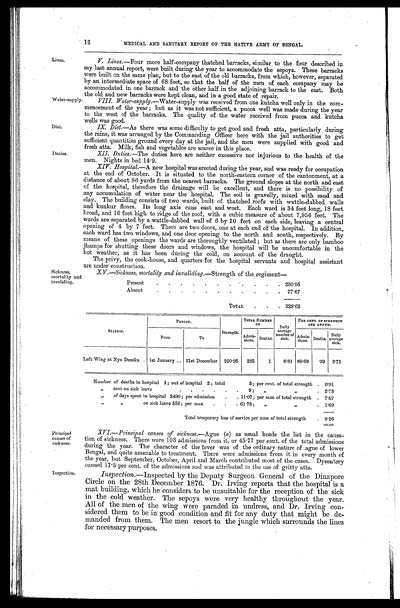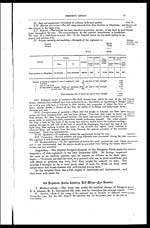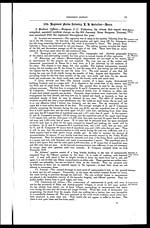Medicine - Institutions > Army health reports and medical documents > Medical and sanitary report of the native army of Bengal > Medical and sanitary report of the native army of Bengal for the year 1876
(42) Page 12
Download files
Individual page:
Thumbnail gallery: Grid view | List view

12
MEDICAL AND SANITARY REPORT OF THE NATIVE ARMY OF BENGAL.
Lines.
V. Lines.— Four more half-company thatched barracks, similar to the four described in
my last annual report, were built during the year to accommodate the sepoys. These barracks
were built on the same plan, but to the east of the old barracks, from which, however, separated
by an intermediate space of 68 feet, so that the half of the men of each company may be
accommodated in one barrack and the other half in the adjoining barrack to the east. Both
the old and new barracks were kept clean, and in a good state of repair.
Water-supply.
VIII. Water-supply .—Water-supply was received from one kutcha well only in the com-
mencement of the year; but as it was not sufficient, a pucca well was made during the year
to the west of the barracks. The quality of the water received from pucca and kutcha
wells was good.
Diet.
Diet. —As there was some difficulty to get good and fresh atta, particularly during
the rains, it was arranged by the Commanding Officer here with the jail authorities to get
sufficient quantities ground every day at the jail, and the men were supplied with good and
fresh atta. Milk, fish and vegetables are scarce in this place.
Duties.
XII. Duties. —The duties here are neither excessive nor injurious to the health of the
men. Nights in bed 14.9.
XIV. Hospital. —A new hospital was erected during the year, and was ready for occupation
at the end of October. It is situated to the north-eastern corner of the cantonment, at a
distance of about 86 yards from the nearest barracks. The ground slopes at the north and east
of the hospital, therefore the drainae will be excellent, and there is no possibility of
any accumulation of water near the hospital. The soil is gravelly, mixed with sand and
clay. The building consists of two wards, built of thatched roofs with wattle-dabbed walls
and kunkur floors. Its long axis runs east and west. Each ward is 34 feet long, 18 feet
broad, and 16 feet high to ridge of the roof, with a cubic measure of about 7,956 feet. The
wards are separated by a wattle-dabbed wall of 6 by 10 feet on each side, leaving a central
opening of 4 by 7 feet. There are two doors, one at each end of the hospital. In addition,
each ward has two windows, and one door opening to the north and south, respectively. By
means of these openings the wards are thoroughly ventilated; but as there are only bamboo
jhamps for shutting these doors and windows, the hospital will be uncomfortable in the
hot weather, as it has been during the cold, on account of the draught.
The privy, the cook-house, and quarters for the hospital servants and hospital assistant
are under construction.
Sickness,
mortality and
invaliding.
XV.—Sickness, mortality and invaliding. —Strength of the regiment—
| Present | 250.95 | |
| Absent | 77.67 | |
| TOTAL | 328.62 |
| STATION. | PERIOD. | Strength. | TOTAL NUMBER OF |
Daily average number of sick. |
PER CENT. OF STRENGTH PER ANNUM. |
||||
| From | To | Admis- sions. |
Deaths. | Admis- sions. |
Deaths. | Daily average sick. |
|||
| Left Wing at Nya Dumka | 1st January | 31st December | 250.95 | 225 | 1 | 6.81 | 89.69 | .39 | 2.71 |
| Number | of deaths in hospital 1; out of hospital 2; total | 3; | per cent. of total strength | 0.91 |
| " | sent on sick leave | 9; | " " | 2.73 |
| " | of days spent in hospital 2490; per admission | 11.07; | per man of total strength | 7.57 |
| " | " on sick leave 556; per man | 61.78; | " " | 1.69 |
| Total temporary loss of service per man of total strength | 9.26 | |||
Principal
causes of
sickness.
XVI.—Principal causes of sickness. —Ague (a) as usual heads the list in the causa-
tion of sickness. There were 103 admissions from it, or 45.77 per cent. of the total admissions
during the year. The character of the fever was of the ordinary nature of ague of lower
Bengal, and quite amenable to treatment. There were admissions from it in every month of
the year, but September, October, April and March contributed most of the cases. Dysentery
caused 17.3 per cent. of the admissions and was attributed to the use of gritty atta.
Inspection.
Inspection. —Inspected by the Deputy Surgeon General of the Dinapore
Circle on the 28th December 1876. Dr. Irving reports that the hospital is a
mat building, which he considers to be unsuitable for the reception of the sick
in the cold weather. The sepoys were very healthy throughout the year.
All of the men of the wing were paraded in undress, and Dr. Irving con-
sidered them to be in good condition and fit for any duty that might be de-
manded from them. The men resort to the jungle which surrounds the lines
for necessary purposes.
Set display mode to: Large image | Zoom image | Transcription
Images and transcriptions on this page, including medium image downloads, may be used under the Creative Commons Attribution 4.0 International Licence unless otherwise stated. ![]()
| Permanent URL | https://digital.nls.uk/74998059 |
|---|




